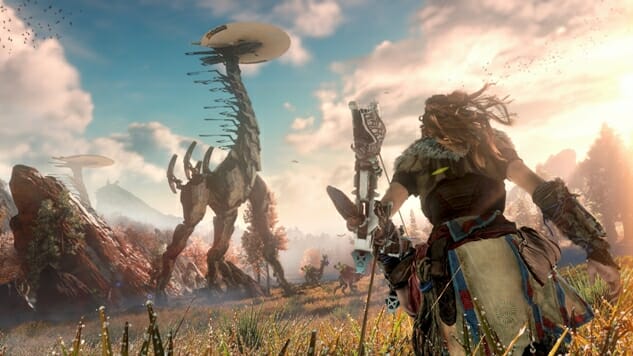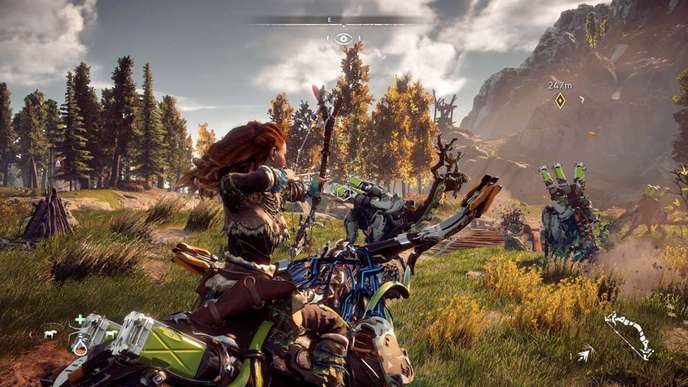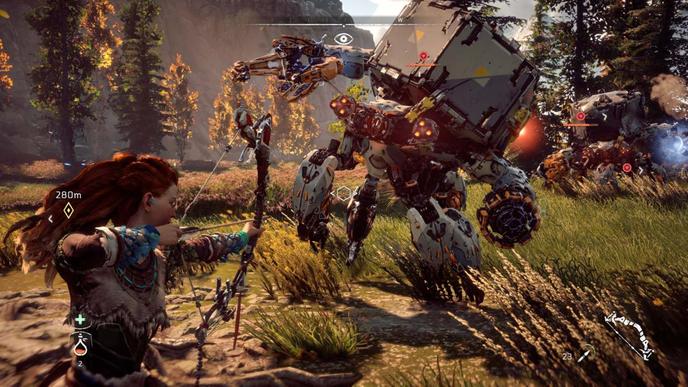Horizon Zero Dawn Scribbles a To-Do List Over a Post Card

Guerilla Games’ Horizon Zero Dawn looks like a living nature painting. As the player runs or rides from one settlement to another, the landscape constantly shifts between distinct, gorgeously realized biomes. One minute, it’s a frozen tundra, with sun gleaming off enormous white, snow-covered cliffs, and ground covered in scraggly little bushes and errant branches. The next, it’s an orange sanded desert with towering red clay mesas jutting up into a perfectly clear blue sky. In each, birds and foxes, boar and rabbits frolic. (And, because Zero Dawn is science fiction, herds of robotic bulls, flocks of giant metal birds or a lone, lumbering cybernetic tyrannosaur.) The world is genuinely stunning, a place that wants simply to be soaked in—observed and inhabited. It is our planet in miniature. It’s the globe shrunk down and captured in a videogame console. Sweep the in-game camera around a landscape and it’s almost possible to smell the air or feel the warmth of the sun.
But, Zero Dawn is an action game, after all, and the screen is covered in reminders of this: A health bar at the top left; an icon displaying potions and another showing weapons and ammunition on the bottom; a line of text summing up the current mission the player is trying to complete. Zoom the map out to find where to go and the priorities of the game become even clearer. Icons—a sea of mission markers, collectable locations and travel-skipping campfire spots—cover the world map like vicious acne. This incredibly realized setting, not allowed to exist for its own sake, is ultimately subsumed by a nearly endless array of activities and busywork, its beauty sacrificed to the god of Content.
Aloy, Zero Dawn’s protagonist, belongs to the Nora tribe, hunter-gatherers who live in a far-flung future where humanity has forgotten centuries of accumulated knowledge and forged new cultures and civilizations. Unlike our own ancient past, the game’s humans live in an ecosystem where autonomous robot animals wander outside cities that range in sophistication from ramshackle collections of huts to a sprawling town surrounding an ornate, Gothic-spired palace.
The setting’s mix of familiar and strange sights draws curiosity. Aloy is motivated to learn about why she had to be raised outside of the Nora tribe—why others say there’s something inherently wrong with her and is shunned as a result. On her journey to uncover her own history, she’s drawn across the entirety of the in-game map, taking in astonishing vistas littered with puzzling industrial wreckage, high tech machines and an array of robot creatures. Zero Dawn isn’t content to allow this welcome sense of mystery to linger. The resulting story mixes a young adult novel’s shallow characterization—Aloy’s personality is nothing but bland heroism, occasional sarcasm and knowledge that she is the world’s “chosen one”—with the dull, self-obsessed historical cataloguing of bad science fiction novels eager to justify their conceits in exhaustive length.
None of the characters feel like much more than chess pieces. They exist only to fulfill roles needed for the plot to develop, spouting information on political and cultural institutions, the back stories of cast members Aloy hasn’t met and other miscellanea better suited to an appendix than labored dialogue sequences. All of this is in service to the most tiring of genre exercises—detailing every possible variable of a fantasy world, giving the audience answers to any possible question about what this world is and how it came to be. If this plot paid off in any interesting ways, it would go some way toward excusing Zero Dawn’s faults. As it is, players are given a predictable science fiction story that attempts, at great length, to condemn environmental exploitation while success in the game itself is predicated on viewing the natural world as nothing more than a wide assortment of collectable resources (more on this in a bit).
The worst tendencies of this storytelling style become particularly clear in a handful of segments where the game forces Aloy to walk—and scan objects with her temple-mounted computer system—through defunct laboratories and research facilities. These spaces are filled with collectable text and audio files and hologram displays that provide exposition and establish new stakes for the plot. The sequences are exhausting, pace-breaking interludes that show a distinct failure to integrate key plot advancements with the rest of the game’s action. The most interesting relate specifically to Aloy’s background. But even as they provide enormous personal revelations for her to react to, the character is too flat to do much more than be taken aback for a few moments and revert back to her usual mode: nondescript adventurer.
Zero Dawn is marginally more successful when keeping Aloy in this role. The mix of combat, climbing and crafting that makes up the rest of the game is superficially enjoyable. The mainstay bows and arrows—varieties include long-range for sniping, armor-chipping for knocking bits off robots and that old standby “on fire”—carry a satisfying rhythm of knocking, drawback and firing. Laying down proximity bombs and exploding trap lines along the holographically marked path of wandering dinobots is a good reward for patience, and simply bashing an enemy with Aloy’s spear offers the welcome feedback of flying sparks and collapsing metal.
The problem comes from stretching these systems to their limits through sheer repetition and a reliance on self-contained arenas filled with overly tough, brain-dead enemies for pivotal battles. As Aloy gains experience points and money to get stronger, aggressive humans and robots simply take more damage in proportion, reducing most strategies to popping health-restoring potions and endlessly plinking away with weapons that exploit a weakness to fire, electricity or ice, or disable glowing body parts. Entering a bandit camp or facing off against an enormous boss robot typically forces the player to run around an enclosed space, taking potshots and properly timing swigs of potion or chomps on medicinal plants until the enemy’s health bar finally empties. When the opportunity arises to clear these areas with tedious stealth—to place markers over enemy positions with Aloy’s holographic scanner and jump out from bushes to one-hit kill a patrolling opponent—it isn’t any more novel an alternative to the bore of all-out combat. It just takes longer and uses up fewer resources.
And stockpiling resources is very important in Zero Dawn. The player must be on constant lookout for materials needed to upgrade her equipment, create ammunition and restore health. Plants and twigs are highlighted throughout the world. Organic animals must be shot for their meat, bones and hides. Different machines are made up of items that are used to craft weapons and armor as well as create important items. Not a moment goes by that something doesn’t dart from the bushes, appear over the horizon or glint along the riverbank that the player, if she wants to get strong enough and well equipped enough to carry on, doesn’t need to run to and collect. The way Aloy moves is hyper-responsive and animated with a fluidity that reinforces her speed and efficiency, whether running up a hill or climbing from handhold to handhold while ascending a craggy mountainside, but it’s impossible to enjoy the care that’s gone into this work when she must stop and start constantly in order to gather new materials with every other step.
This, more than the dull story and tiring combat design, is Zero Dawn’s greatest problem. The need for more collectibles, more crafting resources and more busywork of all kinds clogs up the game, polluting its gorgeous world, throwing a spanner into the joy of its movement design and adding background calculations to every robot hunt that distract from the simplicity of planning ambushes and testing reflexes against a powerful enemy. There’s little value in creating a mountain valley, with crystalline streams running from snow-peaked mountaintops down through golden plains and redwood forests, when the beauty of the location is marred by icons rendered in the garish purple of Aloy’s hologram vision in order to pick out nearby fauna whose Fatty Meat is needed to craft life-saving health potions.
There’s a staggering amount to do and see in Zero Dawn. Unfortunately, none of it is allowed to exist for its own sake. It should be enough just to swim across a river, take in the depths of a valley from high above it or watch the behavior of robotic herds grazing wide open fields. There is much beauty to see in the game’s world—such incredible vision and craft exercised in its conception—but it’s subservient to a poor story, lackluster combat and, worst of all, an evident paranoia that players won’t appreciate the world Aloy inhabits unless it’s put within the context of a laundry list of tasks that have to be completed.
Horizon Zero Dawn was developed by Guerilla Games and published by Sony Interactive Entertainment. It is available for PlayStation 4.
Reid McCarter is a writer and editor based in Toronto whose work has appeared at Kill Screen and Playboy. He is the co-editor of SHOOTER (a compilation of critical essays on the shooter genre), edits Bullet Points Monthly, co-hosts the Bullet Points podcast and tweets @reidmccarter.

